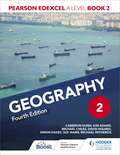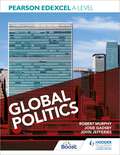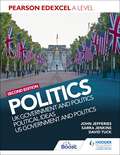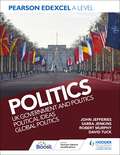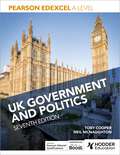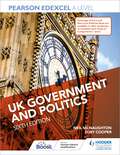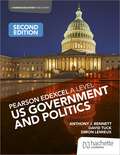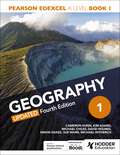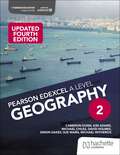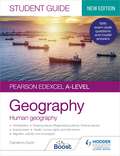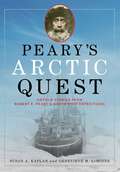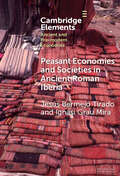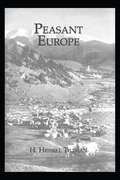- Table View
- List View
Pearson Edexcel A Level Geography Book 2 Fourth Edition
by Sue Warn Cameron Dunn Simon Oakes David Holmes Michael Witherick Kim Adams Michael ChilesCramming all new-case studies, new geographic data and reams of new questions, this new Pearson Edexcel A-level Geography student book will capture imaginations as it travels around the globe.This new book will help your students develop the geographical skills and knowledge they need to succeed. It has been written by our expert author team and structured to provide support for learners of all abilities. The book includes:· Activities and regular review questions to reinforce geographical knowledge and build up core geographical skills· Clear explanations to help students to grapple with tricky geographical concepts and grasp links between topics· Case studies from around the world to vividly demonstrate geographical theory in action· Exciting fieldwork projects that meet the fieldwork and investigation requirementsThis student book is supported by digital resources on our new digital platform Boost, providing a seamless online and offline teaching experience.
Pearson Edexcel A Level Global Politics: Global Politics
by Robert Murphy Eric Magee John Jefferies Josie Gadsby- Newly revised to accompany the Pearson Edexcel specification for Global Politics, with updated case studies and recent developments from around the world- Provides synoptic links within global politics, and across UK and political ideas topics - Includes definitions of key terms and concepts throughout- Includes quickfire knowledge-check questions and summaries of key content to help consolidate knowledge and understanding - Features practice questions throughout, helping students improve their analysis and evaluation skills- Provides answer guidance for exam-style questions online at www.hoddereducation.co.uk/xxx
Pearson Edexcel A Level Global Politics: Global Politics
by Robert Murphy Eric Magee John Jefferies Josie Gadsby- Newly revised to accompany the Pearson Edexcel specification for Global Politics, with updated case studies and recent developments from around the world- Provides synoptic links within global politics, and across UK and political ideas topics - Includes definitions of key terms and concepts throughout- Includes quickfire knowledge-check questions and summaries of key content to help consolidate knowledge and understanding - Features practice questions throughout, helping students improve their analysis and evaluation skills- Provides answer guidance for exam-style questions online at www.hoddereducation.co.uk/xxx
Pearson Edexcel A Level Politics 2nd edition: UK Government and Politics, Political Ideas and US Government and Politics
by John Jefferies Sarra Jenkins David Tuck- Includes all core and non-core political ideas, with key thinkers integrated throughout the text- Builds confidence by highlighting key terms and explaining links between different topics in the specification- Provides opportunities to test your progress with quick knowledge-check questions.- Develops analysis and evaluation skills with 'stretch and challenge' activities and suggestions for targeted further reading.- Features practice questions with answer guidance online at www.hoddereducation.co.uk.
Pearson Edexcel A Level Politics 2nd edition: UK Government and Politics, Political Ideas and US Government and Politics
by John Jefferies Sarra Jenkins David Tuck- Includes all core and non-core political ideas, with key thinkers integrated throughout the text- Builds confidence by highlighting key terms and explaining links between different topics in the specification- Provides opportunities to test your progress with quick knowledge-check questions.- Develops analysis and evaluation skills with 'stretch and challenge' activities and suggestions for targeted further reading.- Features practice questions with answer guidance online at www.hoddereducation.co.uk.
Pearson Edexcel A Level Politics: Uk Government And Politics, Political Ideas And Global Politics
by John Jefferies Sarra Jenkins David Tuck Rob Murphy- Includes all core and non-core political ideas, with key thinkers integrated throughout the text- Provides complete guidance to the Global route of the specification- Strengthens understanding by interweaving both historical context and contemporary examples into the text- Builds confidence by highlighting key terms and explaining links between different topics in the specification- Provides opportunities to test progress with quick knowledge-check questions- Develops analysis and evaluation skills with 'stretch and challenge' activities and suggestions for targeted further reading
Pearson Edexcel A Level Politics: Uk Government And Politics, Political Ideas And Global Politics
by John Jefferies Sarra Jenkins David Tuck Rob Murphy- Includes all core and non-core political ideas, with key thinkers integrated throughout the text- Provides complete guidance to the Global route of the specification- Strengthens understanding by interweaving both historical context and contemporary examples into the text- Builds confidence by highlighting key terms and explaining links between different topics in the specification- Provides opportunities to test progress with quick knowledge-check questions- Develops analysis and evaluation skills with 'stretch and challenge' activities and suggestions for targeted further reading
Pearson Edexcel A Level UK Government and Politics Seventh Edition
by Toby Cooper Neil McNaughtonBuild subject knowledge, develop critical understanding and help students practise the skills they need to succeed in their study of UK Government and Politics. This fully updated textbook for Pearson Edexcel A level Politics will help students develop, understand and engage in the latest developments in UK Government and Politics. Written by Neil McNaughton and revised by Toby Cooper, this new edition is specially designed to reflect the Pearson Edexcel specification and let students approach complex topics with confidence.- Comprehensively covers Government of the UK and Politics of the UK- Places recent developments in a historical context throughout to show the influence of political history on current events- Builds subject confidence by highlighting key terms and explaining synoptic links between different topics in the specification - Develops analysis and evaluation skills through debates and practice questions - Provides answer guidance for practice questions online at www.hoddereducation.com/EdexcelUKPolitics7E
Pearson Edexcel A Level UK Government and Politics Seventh Edition
by Toby Cooper Neil McNaughtonBuild subject knowledge, develop critical understanding and help students practise the skills they need to succeed in their study of UK Government and Politics. This fully updated textbook for Pearson Edexcel A level Politics will help students develop, understand and engage in the latest developments in UK Government and Politics. Written by Neil McNaughton and revised by Toby Cooper, this new edition is specially designed to reflect the Pearson Edexcel specification and let students approach complex topics with confidence.- Comprehensively covers Government of the UK and Politics of the UK- Places recent developments in a historical context throughout to show the influence of political history on current events- Builds subject confidence by highlighting key terms and explaining synoptic links between different topics in the specification - Develops analysis and evaluation skills through debates and practice questions - Provides answer guidance for practice questions online at www.hoddereducation.com/EdexcelUKPolitics7E
Pearson Edexcel A Level UK Government and Politics Sixth Edition
by Eric Magee Toby Cooper Neil McNaughtonThis fully updated Textbook for Pearson Edexcel A-level Politics will help your students develop a critical understanding of the latest developments in UK Government and Politics. This trusted textbook by Neil McNaughton, revised by Toby Cooper, is specially designed to reflect the Edexcel specification and help your students approach complex topics with confidence. This Student Textbook:- Comprehensively covers Government of the UK and Politics of the UK, including the 2019 General Election and the Brexit process- Places recent developments in a historical context throughout to show the influence of political history on current events- Builds your confidence by highlighting key terms and explaining synoptic links between different topics in the specification- Develops your analysis and evaluation skills through debates and practice questions- Provides answer guidance for practice questions online at www.hoddereducation.co.ukHodder Education textbooks covering the Core and Non-Core Political Ideas are available to complete your students' studies for Components 1 and 2 of the Pearson Edexcel specification. Core and Non-Core Political Ideas are compulsory elements of Components 1 and 2.
Pearson Edexcel A Level UK Government and Politics Sixth Edition
by Eric Magee Toby Cooper Neil McNaughtonThis fully updated Textbook for Pearson Edexcel A-level Politics will help your students develop a critical understanding of the latest developments in UK Government and Politics. This trusted textbook by Neil McNaughton, revised by Toby Cooper, is specially designed to reflect the Edexcel specification and help your students approach complex topics with confidence. This Student Textbook:- Comprehensively covers Government of the UK and Politics of the UK, including the 2019 General Election and the Brexit process- Places recent developments in a historical context throughout to show the influence of political history on current events- Builds your confidence by highlighting key terms and explaining synoptic links between different topics in the specification- Develops your analysis and evaluation skills through debates and practice questions- Provides answer guidance for practice questions online at www.hoddereducation.co.ukHodder Education textbooks covering the Core and Non-Core Political Ideas are available to complete your students' studies for Components 1 and 2 of the Pearson Edexcel specification. Core and Non-Core Political Ideas are compulsory elements of Components 1 and 2.
Pearson Edexcel A Level US Government and Politics Second Edition
by Simon Lemieux Anthony J Bennett David TuckHelp your students develop a critical understanding of the latest developments in US Government and Politics with this fully updated textbook for Pearson Edexcel A-level Politics. This trusted textbook by Anthony J Bennett, revised by David Tuck and Simon Lemieux, is specially designed to reflect the Edexcel specification and help your students approach complex topics with confidence. Ensure in-depth coverage of Government and Politics of the USA, with a fully revised and up-to-date approach to recent political developments, including the 2024 US presidential election Enhance students' analytical and evaluation skills through engaging activities, real-world case studies, debates, and exam-style questions Build in-depth knowledge by placing recent political developments in a historical context to highlight the influence of political history on current eventsSupports your students by emphasising key terms and clarifying synoptic links across topics in the specification Find answer guidance for practice questions at www.hachettelearning.com.
Pearson Edexcel A Level US Government and Politics Second Edition
by Simon Lemieux Anthony J Bennett David TuckHelp your students develop a critical understanding of the latest developments in US Government and Politics with this fully updated textbook for Pearson Edexcel A-level Politics. This trusted textbook by Anthony J Bennett, revised by David Tuck and Simon Lemieux, is specially designed to reflect the Edexcel specification and help your students approach complex topics with confidence. Ensure in-depth coverage of Government and Politics of the USA, with a fully revised and up-to-date approach to recent political developments, including the 2024 US presidential election Enhance students' analytical and evaluation skills through engaging activities, real-world case studies, debates, and exam-style questions Build in-depth knowledge by placing recent political developments in a historical context to highlight the influence of political history on current eventsSupports your students by emphasising key terms and clarifying synoptic links across topics in the specification Find answer guidance for practice questions at www.hachettelearning.com.
Pearson Edexcel A-level Geography Book 1, Updated Fourth Edition
by Sue Warn Cameron Dunn Simon Oakes David Holmes Michael Witherick Kim Adams Michael ChilesThis edition is for Issue 6 of the Pearson Edexcel A-level Geography specification, for examination from Summer 2026 onwards.Develop the geographical skills and knowledge that students need with this fully updated textbook from the leading A-level Geography publisher.This book provides in-depth subject coverage and exam support for all compulsory and optional topics.> Learn, understand and revise the content, using clear explanations of every topic, with key terms defined throughout> Develop understanding of geographical theory and concepts with engaging examples and place contexts> Improve understanding through skills-focused activities based on a variety of textual, data and visual sources> Check topic knowledge and identify areas for revision with review questions at the end of each chapter> Approach exams with confidence by working through a variety of practice questions> Be inspired by exciting human and physical geography fieldwork project ideas and guidance for fieldwork and investigations
Pearson Edexcel A-level Geography Book 1, Updated Fourth Edition
by Sue Warn Cameron Dunn Simon Oakes David Holmes Michael Witherick Kim Adams Michael ChilesThis edition is for Issue 6 of the Pearson Edexcel A-level Geography specification, for examination from Summer 2026 onwards.Develop the geographical skills and knowledge that students need with this fully updated textbook from the leading A-level Geography publisher.This book provides in-depth subject coverage and exam support for all compulsory and optional topics.> Learn, understand and revise the content, using clear explanations of every topic, with key terms defined throughout> Develop understanding of geographical theory and concepts with engaging examples and place contexts> Improve understanding through skills-focused activities based on a variety of textual, data and visual sources> Check topic knowledge and identify areas for revision with review questions at the end of each chapter> Approach exams with confidence by working through a variety of practice questions> Be inspired by exciting human and physical geography fieldwork project ideas and guidance for fieldwork and investigations
Pearson Edexcel A-level Geography Book 2, Updated Fourth Edition
by Sue Warn Cameron Dunn Simon Oakes David Holmes Michael Witherick Kim Adams Michael ChilesThis edition is for Issue 6 of the Pearson Edexcel A-level Geography specification, for examination from Summer 2026 onwards.Develop the geographical skills and knowledge that students need with this fully updated textbook from the leading A-level Geography publisher.This book provides in-depth subject coverage and exam support for all compulsory and optional topics.> Learn, understand and revise the content, using clear explanations of every topic, with key terms defined throughout> Develop understanding of geographical theory and concepts with engaging examples and place contexts> Improve understanding through skills-focused activities based on a variety of textual, data and visual sources> Check topic knowledge and identify areas for revision with review questions at the end of each chapter> Approach exams with confidence by working through a variety of practice questions> Be inspired by exciting human and physical geography fieldwork project ideas and guidance for fieldwork and investigations
Pearson Edexcel A-level Geography Book 2, Updated Fourth Edition
by Sue Warn Cameron Dunn Simon Oakes David Holmes Michael Witherick Kim Adams Michael ChilesThis edition is for Issue 6 of the Pearson Edexcel A-level Geography specification, for examination from Summer 2026 onwards.Develop the geographical skills and knowledge that students need with this fully updated textbook from the leading A-level Geography publisher.This book provides in-depth subject coverage and exam support for all compulsory and optional topics.> Learn, understand and revise the content, using clear explanations of every topic, with key terms defined throughout> Develop understanding of geographical theory and concepts with engaging examples and place contexts> Improve understanding through skills-focused activities based on a variety of textual, data and visual sources> Check topic knowledge and identify areas for revision with review questions at the end of each chapter> Approach exams with confidence by working through a variety of practice questions> Be inspired by exciting human and physical geography fieldwork project ideas and guidance for fieldwork and investigations
Pearson Edexcel A-level Geography Student Guide 2: Human Geography
by Cameron DunnReinforce understanding throughout the course with clear topic summaries and sample questions and answers to help students target higher grades. Written by experienced subject expert Cameron Dunn, this Student Guide is divided into two key sections - content guidance, and sample questions and answers. Content guidance will: - Develop understanding of key concepts and terminology in key human geography topics globalisation, regenerating places, diverse places, superpowers, health, human rights and intervention, and migration, identity and sovereignty. - Consolidate knowledge with 'knowledge check questions' at the end of each topic and answers in the back of the book. Sample questions and answers will: - Build understanding of the different question types, so that students can approach each question with confidence. - Enable students to target top grades in their exam paper with sample answers and commentary explaining exactly why marks have been awarded.
Pearson Edexcel A-level Geography Student Guide 2: Human Geography
by Cameron DunnReinforce understanding throughout the course with clear topic summaries and sample questions and answers to help students target higher grades. Written by experienced subject expert Cameron Dunn, this Student Guide is divided into two key sections - content guidance, and sample questions and answers. Content guidance will: - Develop understanding of key concepts and terminology in key human geography topics globalisation, regenerating places, diverse places, superpowers, health, human rights and intervention, and migration, identity and sovereignty. - Consolidate knowledge with 'knowledge check questions' at the end of each topic and answers in the back of the book. Sample questions and answers will: - Build understanding of the different question types, so that students can approach each question with confidence. - Enable students to target top grades in their exam paper with sample answers and commentary explaining exactly why marks have been awarded.
Pearson Edexcel International GCSE (9-1) Geography
by Garrett Nagle Paul GuinnessEndorsed by Pearson EdexcelWith clear and concise explanations, our student textbook covers all the key topics in the Pearson Edexcel International GCSE (9-1) Geography specification. From fragile environments to measuring human welfare, our textbook provides students with a deep understanding of each topic and ensures they are fully prepared for their exams.But it's not just about content knowledge - our Student Textbook is also packed with activities and questions, providing your students with plenty of opportunity to reinforce their learning and hone the skills required to succeed.This Pearson Edexcel endorsed Student Textbook:- develops understanding with thorough coverage of topics and contains summaries, diagrams and plenty of activities to direct thinking and aid revision - provides knowledge tests and exam practice questions at the end of each topic, with detailed guidance and example answers to help reinforce understanding - features up-to-date contemporary case studies, facts and figures, featuring UK and international examples, that build students' geographical skills and captures their interest- stretches, challenges and encourages independent thinking through clear and focused content that incorporates maps, graphs, GIS material and data sources.
Pearson Edexcel International GCSE (9-1) Geography
by Garrett Nagle Paul GuinnessEndorsed by Pearson EdexcelWith clear and concise explanations, our student textbook covers all the key topics in the Pearson Edexcel International GCSE (9-1) Geography specification. From fragile environments to measuring human welfare, our textbook provides students with a deep understanding of each topic and ensures they are fully prepared for their exams.But it's not just about content knowledge - our Student Textbook is also packed with activities and questions, providing your students with plenty of opportunity to reinforce their learning and hone the skills required to succeed.This Pearson Edexcel endorsed Student Textbook:- develops understanding with thorough coverage of topics and contains summaries, diagrams and plenty of activities to direct thinking and aid revision - provides knowledge tests and exam practice questions at the end of each topic, with detailed guidance and example answers to help reinforce understanding - features up-to-date contemporary case studies, facts and figures, featuring UK and international examples, that build students' geographical skills and captures their interest- stretches, challenges and encourages independent thinking through clear and focused content that incorporates maps, graphs, GIS material and data sources.
Peary's Arctic Quest: Untold Stories from Robert E. Peary's North Pole Expeditions
by Susan Kaplan Genevieve LeMoineThis richly illustrated book takes a different angle on Robert E. Peary&’s North Pole expedition. By shifting the focus away from the unanswerable question of whether he truly reached 90º North Latitude, the authors shed light on equally important stories and discoveries that arose as a result of the infamous expedition. Peary's Arctic Quest ventures beyond the well-cited story of Peary&’s expedition and uncovers the truth about race relations, womens&’ scientific contributions, and climate change that are still relevant today. Readers will gain a greater appreciation for Peary&’s methodical and creative mind, the Inughuit&’s significant contributions to Arctic exploration, and the impact of Western expedition activity on the Inughuit community. The volume will also feature artifacts, drawings, and historic photographs with informative captions to tell little-known stories about Peary&’s 1908-1909 North Pole expedition.
Peasant Economies and Societies in Ancient Roman Iberia (Elements in Ancient and Pre-modern Economies)
by Jesús Bermejo Tirado Ignasi Grau MiraThis Element revisits the historiographical and archaeological paradigms of Roman rural economies, with a particular focus on the peasant communities of Roman Iberia. Traditionally overshadowed by the dominance of the villa schiavistica model, which centers on large-scale slave-operated agricultural estates, recent interdisciplinary research has unveiled the complexity and persistence of peasant economies. By integrating data from archaeological surveys, rescue excavations, and textual analyses, this volume highlights the significance of dispersed settlements, small-scale farms, and sustainable agrarian strategies that defined the peasant landscape. Case studies from diverse sectors of the Iberian Peninsula demonstrate diverse modes of land use, such as intensive cultivation, crop rotation, and manuring, which contrast with the economic assumptions tied to elite-dominated production models. Furthermore, the author explores Roman peasants' socio-economic structures and adaptive strategies, emphasizing their pivotal role in shaping landscapes. This Element advocates for reexamining Roman peasantries as active and complex agents in ancient history.
Peasant Europe
by Hessell TiltmanFirst published in 2006. Routledge is an imprint of Taylor & Francis, an informa company.
